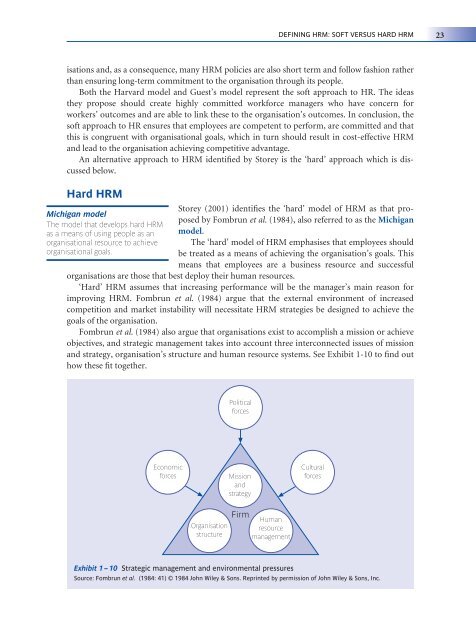The role of human resource management
The role of human resource management
The role of human resource management
Create successful ePaper yourself
Turn your PDF publications into a flip-book with our unique Google optimized e-Paper software.
isations and, as a consequence, many HRM policies are also short term and follow fashion rather<br />
than ensuring long-term commitment to the organisation through its people.<br />
Both the Harvard model and Guest’s model represent the s<strong>of</strong>t approach to HR. <strong>The</strong> ideas<br />
they propose should create highly committed workforce managers who have concern for<br />
workers’ outcomes and are able to link these to the organisation’s outcomes. In conclusion, the<br />
s<strong>of</strong>t approach to HR ensures that employees are competent to perform, are committed and that<br />
this is congruent with organisational goals, which in turn should result in cost-effective HRM<br />
and lead to the organisation achieving competitive advantage.<br />
An alternative approach to HRM identified by Storey is the ‘hard’ approach which is discussed<br />
below.<br />
Hard HRM<br />
DEFINING HRM: SOFT VERSUS HARD HRM 23<br />
Storey (2001) identifies the ‘hard’ model <strong>of</strong> HRM as that pro-<br />
Michigan model<br />
posed by Fombrun et al. (1984), also referred to as the Michigan<br />
<strong>The</strong> model that develops hard HRM<br />
as a means <strong>of</strong> using people as an model.<br />
organisational <strong>resource</strong> to achieve <strong>The</strong> ‘hard’ model <strong>of</strong> HRM emphasises that employees should<br />
organisational goals.<br />
be treated as a means <strong>of</strong> achieving the organisation’s goals. This<br />
means that employees are a business <strong>resource</strong> and successful<br />
organisations are those that best deploy their <strong>human</strong> <strong>resource</strong>s.<br />
‘Hard’ HRM assumes that increasing performance will be the manager’s main reason for<br />
improving HRM. Fombrun et al. (1984) argue that the external environment <strong>of</strong> increased<br />
competition and market instability will necessitate HRM strategies be designed to achieve the<br />
goals <strong>of</strong> the organisation.<br />
Fombrun et al. (1984) also argue that organisations exist to accomplish a mission or achieve<br />
objectives, and strategic <strong>management</strong> takes into account three interconnected issues <strong>of</strong> mission<br />
and strategy, organisation’s structure and <strong>human</strong> <strong>resource</strong> systems. See Exhibit 1-10 to find out<br />
how these fit together.<br />
Economic<br />
forces<br />
Organisation<br />
structure<br />
Political<br />
forces<br />
Mission<br />
and<br />
strategy<br />
Firm<br />
Human<br />
<strong>resource</strong><br />
<strong>management</strong><br />
Exhibit 1–10 Strategic <strong>management</strong> and environmental pressures<br />
Cultural<br />
forces<br />
Source: Fombrun et al. (1984: 41) © 1984 John Wiley & Sons. Reprinted by permission <strong>of</strong> John Wiley & Sons, Inc.

















